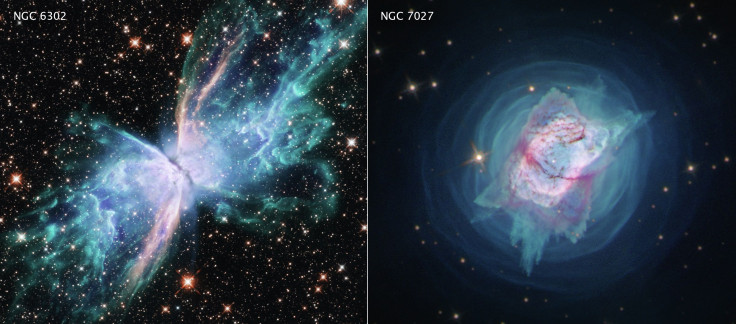NASA Studies Contrasting Star Explosions In New Hubble Photos

KEY POINTS
- Hubble Space Telescope took new images of two different planetary nebulas
- Scientists were able to collect new information regarding the formation of the nebulas
- The shapes of NGC 6303 and NGC 7027 may have been formed by binary star systems
New images captured by the Hubble Space Telescope allowed NASA scientists to collect new information on two different nebulas. These massive cosmic structures were formed following the death of two red giant stars.
Hubble’s latest images feature the planetary nebulas known as NGC 6303 and NGC 7027. NGC 6302 is often referred to as the Butterfly Nebula due to its distinct shape, which resembles the wings of a butterfly.
NGC 7027, on the other hand, has a circular shape with a central structure that looks like a jewel bug, which is an insect that has a bright and colorful shell.
Hubble has already taken photos of these two different types of nebulas before. However, this is the first time that the space telescope took images of the nebulas under different wavelengths using its Wide Field Camera 3. Through the multi-wavelength images, NASA’s scientists were able to collect new information regarding the characteristics of the nebulas.
“When I looked in the Hubble archive and realized no one had observed these nebulas with Hubble's Wide Field Camera 3 across its full wavelength range, I was floored,” lead researcher Joel Krastner said in a statement.
“These new multi-wavelength Hubble observations provide the most comprehensive view to date of both of these spectacular nebulas. As I was downloading the resulting images, I felt like a kid in a candy store,” he added.
Both nebulas were formed after two red giant stars reached the end of their life cycles. During this stage, the stars began to shed off their outer shells, creating massive clouds of jets and hot gas around them.
As for the contrasting and complex shapes that they formed, the scientists believe that these were caused by the original state of the stars. According to the scientists, NGC 6302 and NGC 7027 most likely started off as binary star systems composed of two stars orbiting one another.
As the stars orbited each other, they produced a massive disk of gas around them, which eventually became the source of the nebula’s outflowing material. The scientists believe that as one of the stars in the system died, the smaller orbiting star may have merged with it.
This process might have triggered jet emissions from the merging stars, causing the nebulas to form bizarre shapes.
“The suspected companion stars in NGC 6302 and NGC 7027 haven't been directly detected because they are next to, or perhaps have already been swallowed by, larger red giant stars, a type of star that is hundreds to thousands of times brighter than the Sun,” researcher Bruce Balik stated.
“The hypothesis of merging stars seems the best and simplest explanation for the features seen in the most active and symmetric planetary nebulas. It's a powerful unifying concept, so far without rival,” he added.
Details of the study conducted by the scientists were presented in a new paper published in the journal Galaxies.
© Copyright IBTimes 2025. All rights reserved.





















